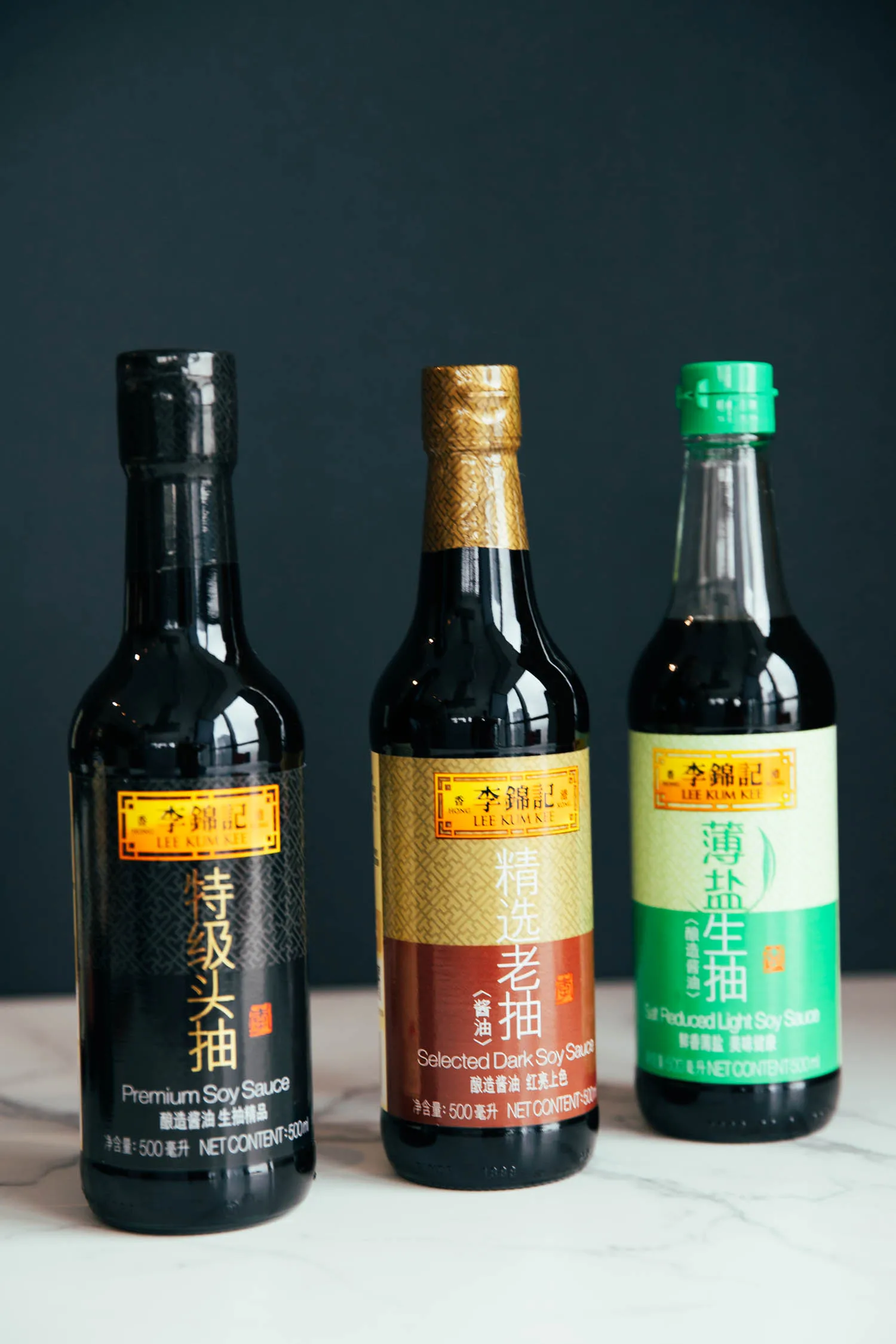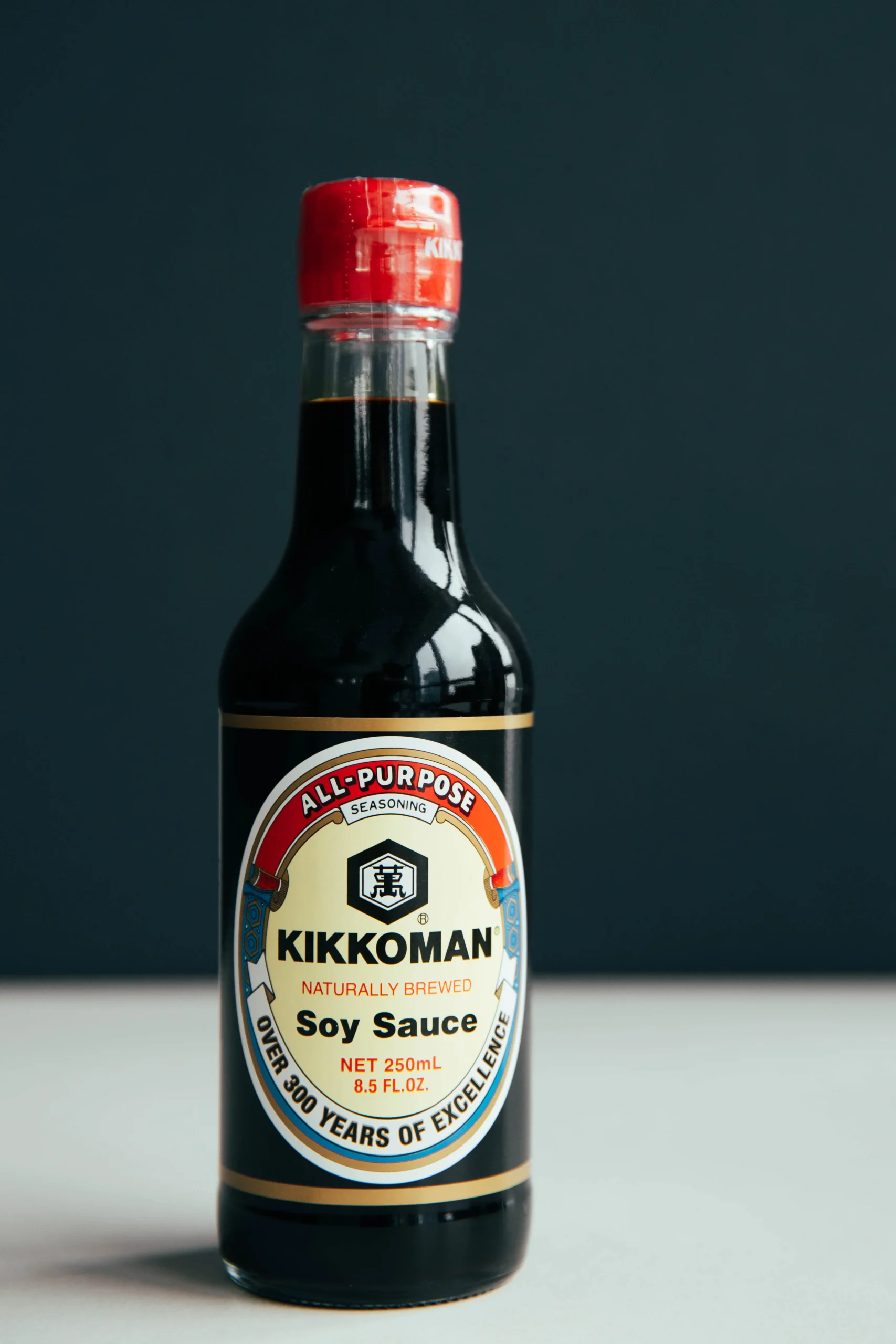This is my ultimate guide to Chinese soy sauce. If you are a returning visitor, you may find most of the recipes on the blog call for soy sauce. This guide will tell you what is soy sauce, how to use them, and different types and flavors and their difference among each other.

What’s soy sauce
Soy sauce is a traditional Chinese liquid condiment and other Asian cuisines are used to flavor dishes with or as a dip. It is a brown liquid sauce made from soybeans, wheat, and salt. It is used as a seasoning or condiment in Chinese food and other Asian cuisines. This inky brown sauce is often used as a seasoning, giving food a boost of savory flavor and umami goodness. Many people use soy sauce instead of salt when seasoning food. And you should definitely try to find a balance for the salty flavor.
How Soy Sauce is Produced
Soy sauce traditionally takes around six months to produce, or sometimes longer. The traditional ingredients include fermented soybean paste, roasted grains, salt brine, and certain molds. Soy sauce is the liquid result, or product, of wheat paste and fermented soybean. Sugars are released during the fermentation process, and the lovely translucent brown liquid is born. The soybeans and wheat are made into a paste, and then molds are added or obtained from the natural environment to begin the fermentation process. The fermentation is a further step on fermented beans- douchi. Nowadays, commercial producers use alternate vegetable proteins in place of molds and cultures to speed up the process.
There are two main types of soy sauce with slightly different methods of fermentation. Light soy sauce (生抽) and dark soy sauce (老抽). If you find a recipe that calls for soy sauce without any further note, then it is referring to light soy sauce.
Light soy sauce
Light soy sauce has a thinner, more inky appearance than other soy sauces. Despite this, it still packs some incredible unami flavor. Light soy sauce is also known as Chinese-style soy sauce and is full of delicious monosodium glutamate, which is responsible for the delightful umami taste tones. Please note, light soy sauce is not to be confused with “low-sodium.” On the contrary, light soy sauce is actually saltier than most other types of soy sauce. But I highly recommend you try “low sodium” light soy sauce because it gives more space for other seasonings.
How to use light soy sauce
Light soy sauce can be used for a variety of purposes: as a marinade, stir-fry sauce, braising liquid, and soup flavoring. You can also use it for dipping sauces.
Dark soy sauce
Dark soy sauce has a thicker consistency and deeper flavor due to its being fermented for a more extended period of time than light soy sauce. In addition to this, dark soy sauce has added sweeteners such as molasses. Molasses also contributes to the thicker viscosity of dark soy sauce and also the dark red color. In most cases, dark soy sauce is called in order to add colors to dishes like red braised dishes or common stir-frying.
There is one unique type of dark soy sauce- mushroom dark soy sauce. Mushrooms are naturally high in umami, and therefore mushroom soy sauce is a rich-tasting soy sauce. This variety is essentially a variation of dark soy sauce. This sauce is often used with pork and meat, where the intention is to get a really rich-looking glaze on the meat. It’s a very popular sauce to use in stir-fries and in tofu which holds the flavor of the sauce really well.
Adding mushroom soy sauce to a dish with mushrooms in it delivers an umami taste celebration and is so delicious.
Regular soy sauce
If there is no separation of light soy sauce and dark soy sauce, then we have a type combined with both types- regular soy sauce. It is less common now because light soy sauce + dark soy sauce can provide more creative chances for chefs. But there are still some popular brands offering regular soy sauce.

Thick soy sauce paste (酱油膏)
This one is popular and originated in Taiwan. It is much thicker, with a similar texture to oyster sauce, than regular soy sauce and is widely used in Taiwanese recipes like Lu Rou Fan. You can also add it in common stir-frying recipes just like using oyster sauce.
How long can soy sauce last
An unopened bottle of soy sauce can last around three years. It’s highly likely that the bottle will be finished long before its expiry date.
Soy sauce doesn’t need to be kept inside the refrigerator, although you can store it there if you prefer. Due to the fermentation of the ingredients, an open soy sauce bottle can last, outside the fridge, for around a year.
The flavor may mellow out a bit during this time, but the soy sauce will not go bad. To extend the shelf life of your soy sauce, keep it in a grocery cupboard or fridge, away from heat and direct sunlight, much like the other sauces and oils in your pantry.
Soy sauce substitutes
Here are a couple of soy sauce substitutes that you can use if you don’t have access to soy sauce or are looking for an alternative for dietary reasons:
· Dehydrated mushrooms. Soak a few dried shitake mushrooms in hot water and then use that liquid in place of soy sauce. This is a wonderful gluten and sodium-free alternative that is laden with natural umami.
· Miso paste. As a fellow fermented and umami-rich ingredient, miso paste can be mixed with a bit of water to create an excellent alternative to soy sauce.
· Fish sauce. This isn’t the perfect substitute for every recipe but fish sauce certainly does season and amp up the flavor nicely.
· Salt. Easy and accessible. Salt isn’t going to give your dish nearly the same depth of flavor as soy sauce will. It certainly won’t leave you with a bland dish.
· Chicken or vegetable broth. With this alternative, the dish will be full of tasty savory flavor notes and will be beautifully seasoned.
Soy sauce calories
There are roughly 8 calories in one tablespoon of soy sauce.
Is soy sauce keto
Due to soy sauce containing 0.7 grams of carbs per tablespoon, a lot of people will include it as part of their keto diet. The jury is still out on this query, though as there are many keto dieters who choose not to include it in their meal preparation. It depends on how strictly the diet is being followed. For some folks, the fact that soy sauce is made from wheat and soybeans makes it keto unfriendly.
Is soy sauce gluten-free?
Traditional or regular soy sauce is made with the inclusion of wheat and is, therefore not gluten-free. But there are gluten-free soy sauces that exclude wheat completely during the fermentation process.
Recipe inspirations
The followings are some of the recipes that feature soy sauce as the main seasoning. So you can taste the real unami flavor bought by soy sauce.
- Soy Sauce Fried Rice
- Chinese Soy Sauce Eggs
- Easy Chinese Soy Sauce Chicken
- Yang Chun Noodles—Easy Soy Sauce Noodles
- Sichuan Soy Sauce Noodles
- Soy Sauce Pan Fried Noodles (Cantonese Chow Mein)
- Sichuan Sweetened Soy Sauce
I hope you know the basic of the soy sauce used in Chinese cooking. For any comments, please make a comment or tag me on Ins.
